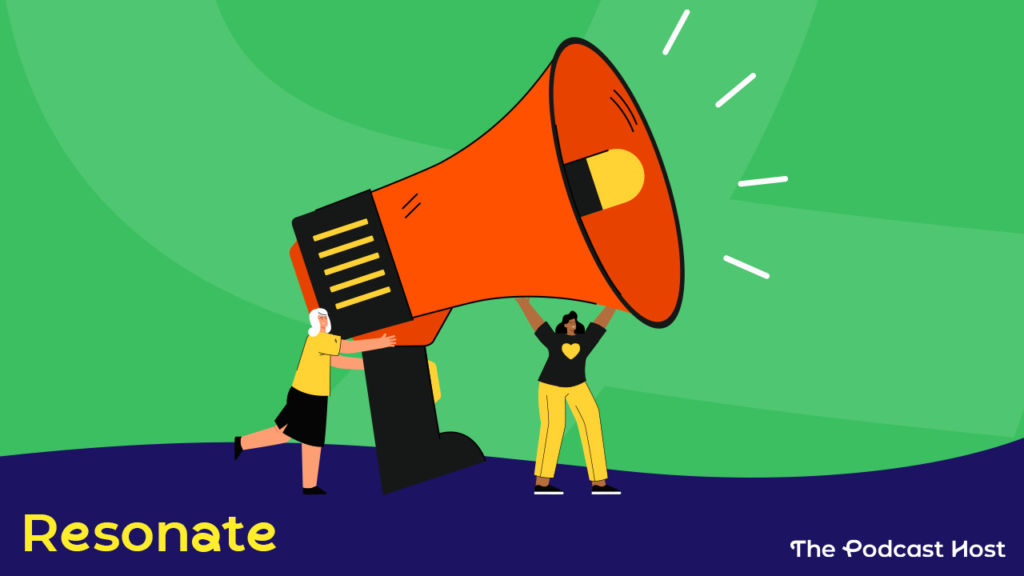Can You Grow a Podcast Without Social Media? It’s a RACE

TLDR: Is it possible to launch and grow a podcast without using ANY social media? Yes. Yes, it is!
I was talking to an aspiring podcaster, recently. They’d asked for tips and advice on getting set up, and I said something that made them stop me and repeat myself.
“… if you don’t use social media…” was the remark I’d made. I didn’t think it was an outrageous thing to say. But then again, it wasn’t the first time I’ve had this reaction.
We chatted about it, and they were amazed that anyone would consider starting a podcast without a handful of social media accounts to accompany it. “But how would you even promote it?” was one question.
So I said, “Let me fetch my laptop machine and type you up a guide”. (I didn’t say this at all, but I live to rue the missed opportunity).
Anyway, I managed to take all the “here’s what to do” stuff and somehow beat it into a semi-presentable acronym: RACE. It has 13 steps, but let’s not get superstitious about it.
The RACE method is perfect for podcasters looking to ignore Instagram, put the block on TikTok, or flush Twitter down the… (wait, Musk already did that, didn’t he?).
What Do You Mean by “Without Social Media?”
I know, there’s no worse way to start an article than with a bunch of caveats and qualifiers, but this one feels unavoidable upfront, so here goes.
Social media CAN still play a role in growing your podcast, but the key here is that you don’t need to use it.
I’m also not trying to tell you not to use social media. If you enjoy these apps, then scroll them til your heart’s content. The key aim here is to tackle the assumption that you must use social to grow your podcast. Not only that, but to provide a clear alternative, too.
FAQ: If Listeners Don’t Find Podcasts on Social, How DO They Find Them?
If I don’t answer this question now then you might spend the rest of this article with a “but…” on the tip of your tongue. So here’s some of our own data to ease you in.
A few years ago, we ran a survey asking podcast listeners how they discovered new shows. Here are the results:
- 40% search their podcast listening app’s directory
- 18% directly ask someone they know for recommendations
- 15% ask on social media or in an online community
- 14% search Google
- 13% browse a podcast chart or “featured” section
So the answer is that some actually do find podcasts on social, but it’s more about word of mouth recs than direct self-promotion.
Now, let’s get back to my quirky wee acronym, and we’ll pick up on this thread again shortly.
The RACE Method for Podcast Growth Without Social Media
The beauty of this race is that you don’t have to tie your pal’s leg to your own, run with an egg in a spoon, or pretend to be a wheelbarrow.
RACE stands for
Resonate
Assemble
Collaborate
Enhance
This post has a couple of affiliate links to products and services we recommend highly. We’d earn a small commission should you choose to sign up through them – though never at any extra cost to you!
Resonate

This is all about choosing a topic with a clearly defined audience and serving them something they need or want in a unique way.
This is the no-brainer of any type of content creation – does it resonate?
Is there a group of people out there (no matter how small) who would look at your overall podcast topic and think, “This feels like it was made exactly for me”?
This is a huge subject in its own right, and one we deal with in great detail in our Guide to Podcast Topics. But to save you a click, I’m talking about that secondary angle of your show. For example:
- The D&D Podcast FOR Single Parents
- The Running Podcast FOR Retirees
- The Fiction Writing Podcast FOR Visually Impaired People
If you cut these examples off before the “FOR,” they are much too generic to gain a foothold. So identify who your people are and make sure you signpost them in your podcast name, too.
This stuff is podcasting 101, but without it, the rest of the advice here will be useless.
Now, we can move on to some more RACE-specific strategies…
1. Keep Your Episodes Evergreen
Can you keep your episodes evergreen? Or, at least, not overly time-sensitive? A huge driver of podcast growth is a show’s back catalogue. If you can build that body of work to 30 episodes and beyond, each new listener who discovers you can duly binge your content and spend a lot of time with you. This is how people transition from “listeners” to “fans”.
2. Write Down Ten Compelling Episode Titles
Based on your overall topic, can you write down ten compelling episode titles? These should correspond to ten great discussions, answers to questions, or solutions to problems.
Imagine your ideal listener searching their podcast app and finding your show. What are the ten episode titles that’ll have them hitting play without a second thought? Think of this as early wins, low-hanging fruits, or “strategic alignment” if you want to get all fancy about it.
These tactics ensure your podcast is discoverable, even without posting a single thing on social media. Your podcast name and episode titles will be search-friendly in places like Apple Podcasts, Spotify, and the many other apps podcast listeners are using. And they’ll be irresistible to any of your target audience who happen across them, too.
Okay, lap one completed. Let’s kick on…
Assemble

This is all about how to put your podcast together in the most sustainable manner and turn it into an audience growth machine.
Building a chunky back catalogue full of value-packed episodes is no quick and simple task. It might take you a year to hit that critical mass of 25-30 episodes, where you start to see the wheels beginning to turn.
The sobering advice here is to “strap in and prepare to play the long game.” But I’ll offer more than just a “good luck!” here.
If you want your podcast to see its first birthday or its fiftieth episode, then it needs to be sustainable. Don’t be tricked by your early pre-launch or first-episode enthusiasm. Motivation alone won’t keep this car on the road.
3. Choose an Optimal Format
Again, a bit of podcasting 101, but you need to find the format that works best alongside your job, schedule, or life. If you work long hours or reside in a timezone that seems to be at odds with the rest of the world, is an interview show really the best approach? If you go solo, then scheduling is entirely on your own terms. And the beauty of podcasting is that you can always mix it up later on if your situation changes. Just don’t set yourself up to fail on day one with an unrealistic format.
4. Keep Tools & Gear Simple
Gear and software recommendations are a huge part of what we do here at The Podcast Host. But if there’s one thing I’ve learned by reviewing hundreds of mics, recorders, and software programs over the years, it’s that you can make a little go a long way. Don’t overcomplicate things by constantly adding to your stack because you’ve heard about some new tech that might potentially have some cool feature.
Our Best Podcast Tools roundup covers the stuff that’ll save you time, money, and subscription overload. A shout out, too, to our own podcast-maker tool Alitu, which has recording, editing, publishing (and loads more) built-in. Bottom line, though – whatever you choose and use, make sure it has earned its place in your workflow.
5. Take an “Audio-First” Approach
Video in podcasting is similar to social media in that there’s a widespread assumption that you must use it. For most podcasters, video isn’t a good fit for a number of reasons, ranging from extra time and budget requirements to increased technical know-how. Rest assured; you can put your podcast on YouTube without recording a single second of visual footage. And, like anything else in podcasting, you can go all-in on video further down the line if it feels like the right move.
6. Add in Seasonality
Playing the long game doesn’t mean swearing an oath to grind out new episodes every week for the rest of your life. Many successful and long-running creators employ a seasonal approach, much like your favourite TV shows. Here, you can focus on creating a block of, say, eight to twelve episodes and then take a well-earned rest to recharge and begin planning the next one. With no actual data to back it up, I’m going to make the claim that, if you do seasons, you’re more likely to keep going.
So that brings us to the end of our ‘Assemble’ strategies. We’ve covered a lot of ground so far, but I never promised this was going to be a “one simple trick” method, did I?
Anyway, onwards to the C in RACE…
Collaborate

Now, we’ll look at some unique ways to work with other podcasters to grow your show.
Podcasting is Schrödinger’s content medium. It’s both very social and very isolated. While the job of making the thing falls to you alone, there’s no getting around the fact that other people shape what the podcast becomes. And that extends beyond the folks playing you through their earbuds. With that in mind, here’s how to grow your podcast through collaboration.

Remember!
“But you said I didn’t have to do interviews!” – You don’t. But it’s your show, and you can mix it up from time to time. Don’t close the door on these strategies or one-off opportunities because you’ve put an artificial limitation on your podcast format!
7. Speak to Another Podcaster in Your Niche
No matter what you’re podcasting about and who you’re podcasting to, there will be another show out there doing something similar. If you find a podcast like this, the worst thing you can do is treat it like competition. Podcasting is on-demand, so don’t worry about listeners tuning in to them instead of you.
On the contrary, if you like what that creator is doing, invite them on to your show. This could be a straight-up interview, or they might be open to a “co-hosted” episode that gets published on both feeds. The outcome is a shared audience, many of whom will want to subscribe to or follow both podcasts, going forward. Not only that, but you’ll make a new pal, too. And you can never have enough pals!
8. Secure a Known Name in Your Space
This isn’t an instruction to go out there and “find a famous person.” But in any industry, topic, or niche, there are “celebrities,” and they’re more often than not accessible and open to podcast chats.
I had a nice bump of early growth in my tabletop hobby show because I invited a well-known (in my niche) games designer. This wasn’t a cynical attempt to get in front of his audience; it was because I was enthusiastic to chat with him and knew my fledgling band of listeners would enjoy it, too. The conversation went well, and he did share it with his fans, many of whom stayed on to listen to my other episodes. Not only that, but my existing core of listeners shared it out amongst themselves, too. This really gave the podcast an early boost in numbers and engagement.
9. Appear on Another Podcast
I know… “Go and be interviewed on another podcast” seems as helpful as saying, “Go and create viral content”, but stick with me.
The obvious reasoning here is that having the opportunity to bring value to an audience of podcast listeners on another show might also positively impact your podcast.
The snag seems to be that we’ve all had those toe-curling emails from aspiring guests or the agencies they’ve unfortunately hired. I get a lot of them for my audio drama series, so you can spot the “spray and pray” approach a mile away.
The idea here is to do something a lot more meaningful. As I’ve mentioned already, there will be other podcasts out there with a lot of topical overlap with your own. The “co-hosted” approach discussed earlier could work well, here. But if not, why not reach out to that podcaster in video or audio form? Propose a topic that you’d be interested in coming on to talk about, and elaborate on why you think their audience will love it. This approach is a million miles away from the spammy written email approach. Yes, you can only realistically approach a couple of shows this way – as opposed to hundreds – but that’s the whole idea.
A final tip on this front is that some podcasts solicit voice feedback to play on their episodes, often with “question of the month” style features. So, there might even be a way to get involved without having to sync up for an interview.
And that brings down the curtain on our ‘Collaborate’ section. We just have one more step to take to finish this RACE, and it begins with E…
Enhance

The icing on the cake is to support your quality audio content with the written stuff that will help it be discovered, add more value, and optimise its growth.
Audio is a brilliantly powerful medium, but it’s inherently tied to the written word. This extends far beyond your podcast’s name and episode titles. Show notes enhance the value of an episode by providing a summary of key talking points, and a list of links to resources mentioned. You can take this a step further by running a website for your podcast and treating your shownotes like a complementary blog.
10. Create a Website
“Keep tools and gear simple, you said – now you want me to build a website!?”
Having your own podcast website is a great way of being discovered by the folks who use Google, Bing, or other search engines to seek out their next binge listen.
When you create your podcast in your hosting account, a basic website will be created for you automatically. Default hosting sites are fine, and they can still work. But if you find yours a bit lightweight, I’d recommend using Podpage.
Podpage is a podcast website builder that will create a great-looking, feature-packed site for you in literally minutes. It has more options and tools than you’ll ever need, whilst demanding no technical know-how. You’ll find a deeper dive in our dedicated Podpage review, but key factors for our strategy today are blogging, SEO, and email marketing tools.
11. Run a Blog
Again, this doesn’t necessarily mean adding loads of extra work to your already tight schedule. Blog posts are really just show notes, and you’re already writing those. As for the subject matter, you’ve nailed that down in the episode itself. So, this is more about content stacking than venturing out into a completely new medium.
If you hate writing, then there are loads of AI tools for podcasters that can help you structure and clarify your message. You can use the key talking points from episodes to generate a first draft, which you can then edit into your own words. Some AI tools will automatically transcribe your episodes and generate draft show notes for you, too. The point is, it isn’t hard to create a decent 600-800 word write-up for each episode.
12. Optimise for SEO
(In case you’re wondering – SEO stands for Search Engine Optimisation)
Remember those ten compelling episodes we talked about earlier? Now, you want to turn their corresponding blog posts into SEO-optimised blog posts. We want people searching for these topics to land on your site, see your podcast, and start listening.
Podpage has a brilliant suite of SEO optimisation tools that’ll help you hone these posts. But if you’re not using Podpage, you can still do question research to find out what your target audience is searching for and tweak your content accordingly.
13. Add an Email Newsletter
The piece of written content accompanying each episode acts as both show notes and a blog post, so why can’t it be an email, too?
Well, it can. Not only that, but it should be.
Running an email list is another way to stay in direct contact with your audience. Podpage has an email list tool, so that’s yet another thing you can manage there. If you want a dedicated email platform with tonnes of options, Beehiiv is also great. Check out Lindsay’s full review of Beehiiv if you’re buzzed about that idea.
You might eventually start to experiment with email content that goes beyond the topic of each episode. This could be anything from an automated sequence that teaches something, to regular behind-the-scenes updates, product sales or special offers. Just remember not to bite off more than you can chew, and always keep it sustainable.
The End of the RACE: You CAN Grow a Podcast Without Social Media
So there you have it: a fully-fledged launch and growth strategy that doesn’t require a single tweet, post, “story,” or short from you.
Again, you’re free to use any social media app that you like, but if you’d prefer not to, rest assured that it won’t hamper your podcast in the slightest. Maybe some of your content will end up doing really well on social, but it doesn’t need to have come from you.
This also isn’t a “one simple trick” strategy, and I never claimed it to be. There’s loads in here, and running a successful podcast is hard. But it can be enjoyably hard (maybe a better word is “challenging”) as opposed to gruelling.
On a final note, if you like the thought of engaging with other like-minded podcasters but don’t like all the other baggage that comes with social media, then check out the IndiePod Community. It’s a lovely community full of indie podcasters who’re in the same boat as you. No doomscrolling required!
